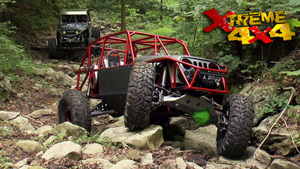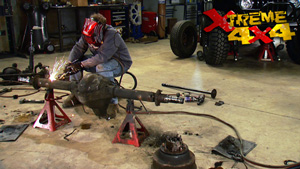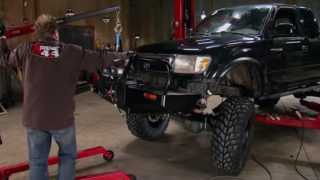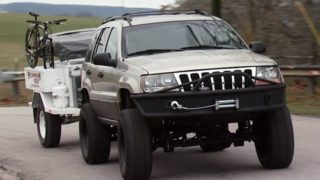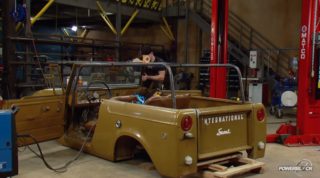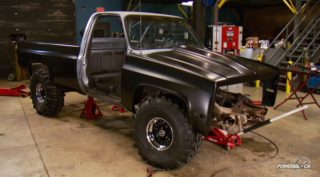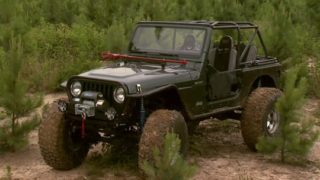More Budget TJ Episodes
Xtreme 4x4 Builds
Want more content like this?
Join the PowerNation Email NewsletterParts Used In This Episode
ARB 4x4 Accessories
ARB Air Locker Locking Differential
ARB 4x4 Accessories
ARB Air Locker Locking Differential (Front)
ARB 4x4 Accessories
High Volume On-Board Air Compressor
Gen Right Off Road
Hi-Fender Tube Fender Kit
Gen Right Off Road
JK 4 Door Rocker Guards
Gen Right Off Road
JK Aluminum Rear Bumper
Gen Right Off Road
JK Aluminum Rear Tire Carrier
Gen Right Off Road
JK Front 4" Wide Tube Flare Aluminum"
Gen Right Off Road
JK Front Aluminum Bumper with Trail Series Stinger
Gen Right Off Road
JK Rear 4" Wide Tube Flares Aluminum"
Maxxis International
40 X 13.50 - 17 Maxxis M8090 Creepy Crawler.
RCV Performance Products
Dana 60 CV Axle Set\r\n
RCV Performance Products
Ultimate Full Floater Rear Axles 4340 Chrome Moly Steel
Warn Industries
Manual Locking Hub Set
Episode Transcript
What's bigger is better and what's better is certainly stronger. Today on Xtreme 4x4 final heavy duty upgrades for R TJ. Then six cylinder day on extreme,
the Jeep hits the trail for a shoot out with AJ K.
Today, we've got a project that we dubbed our budget TJ back in the shop to finish up a bunch of work on it and then take it out wheeling. Now, a lot of you guys have had issues with the term budget as it applies to this project saying that we just threw a bunch of money at this truck to get it done. And although I will admit that this vehicle represents a significant investment when it comes to building a hardcore off road truck. It's not about how much money you spend.
It's about where you spend it.
We already built a truly over the top TJ. When we took a 2003, Jeep stripped it down and threw almost every hardcore off road part. We could find
hemi V8
long travel suspension, four speed Atlas transfer case and a set of fully built crate axles
and it worked great
on this TJ. We took a slightly different path
starting with a good used 97 TJ.
We installed a gen right off road high line package
that raised the fender opening and provided the truck with excellent body protection.
This high line kit allowed us to install a very reasonable terra
flex four inch suspension system
by not building a custom suspension. We save not only time
but also money
on the drive train. If you want to keep cash in your pocket, there's nothing wrong with the stock straight six engine that Jeeps have had under the hood for years. So we left ours alone, simply installed a slip Yoke Eliminator into the transfer case.
Nothing's gonna save you more cash than building your own axles. So after a call to a couple of junk yards, we had two Dana sixties in the shop ready to be cut up.
And once shortened, we used an off the shelf bracket kit to hook them up to our factory suspension.
And then finally we slipped on some maxis 40 inch tall creepy crawlers mounted on 17 inch allied monster bead locks. And those are some of the examples. I mean, about spending your money in the right place. Absolutely. A 100% custom suspension system would definitely perform better. But the off the shelf kit not only saved us money, but it also saved us time when you build a hard core off road truck. It's often what it's all about making those decisions. Some save you time. Some, save you money. Some actually sacrifice the strength of your rake. And that's what we're gonna do today. We're gonna go over all the different options you have while finishing out the odds and ends on this TJ.
Come on.
Oh,
custom with axle shafts. Give you a bunch of different options. You have material choice options like chrome moley or 300 M. Now. Chrome moley is a little bit cheaper and the 300 m is a lot stronger, but you don't need 300 M on a trail truck. Chrome Molly will do just fine. Leave the 300 M for the race cars with a little bit of planning. You can save a little bit of money based on your design. Now, we cut up a rear 60 for the best
of this jeep and we plan from the very beginning to have both rear axle shafts, the exact same length. Now this saves us money based on our trail spare axle, the shaft you carry in case you break an axle shaft by having both rear shafts the same length. It doesn't matter if we break the right or the left rear, we can just swap in the trail spirit to get us off the trail. Now, our shafts are from our CV performance and they are a
blind and shaft on both end making them incredibly strong. They use a unique drive flange set up to connect to the hub and then it has this dust boot to go over the outside to protect the flange and the circlip. Now, steering axles have always been the norm. You'd see an inner and outer axle stub with these ears and a U joint to connect the two, you could buy upgraded U joints to make them a little bit stronger. But
our CV does things a little bit different. They use a true CV or constant velocity style joint. Now, this has six balls in it that distribute the load that make it incredibly strong, sometimes even more strong than a U joint design. They're fully serviceable with this grease fitting on the outside and a dust boot to cover it up and protect it for when you're on the trail or on the road.
Upgrading to these constant velocity style shafts from our CV is a little more expensive than the U joint style axles.
But if you take into account that they carry a U break it, they replace the warranty, the extra money spent up front is far less than the replacement cost of another shaft.
Our CV not only makes these custom length units, but they also have direct replacement shafts for everything from day. The 30
to diesel tow
rings,
your wheel hub is the final connection between your entire drive train and the ground and you have a couple different options for them.
You can install a set of classic free wheeling hubs that allow you to unlock or lock the drive train to the tire and wheel or you can replace those with what is called a drive flange or drive puck. And there's a couple of benefits and drawbacks to each. The drive puck is obviously solid. It's a 100% connection to the wheel and the drive train at all times. And it's usually made at a very strong 4340 chrome Molly steel because it sees a large amount of abuse usually only used for trail, only rig something you're gonna tow to the trail. If you're gonna drive your vehicle on the street at all. A better option is to go with the freewheeling hub.
The freewheeling hub assembly allows your axle to spin freely of the tire and wheel until you engage it or lock it into place. Now, that will allow you to unlock the tire and wheel in case you need to drive on the pavement.
Another nice thing about the free wheeling hub is it acts like a fuse in your drive train. It will be the first part that breaks if you get into a serious bind, that may sound like a drag, but it's a lot cheaper than replacing a drive shaft or an axle shaft,
whether you choose to run a hub or a flash. It's a good idea
to ditch the stock jam N style
spindle nuts for the new stage eight X locks.
The X lock uses a key washer and a snap ring to prevent any loosing of the outer bearing retaining that
this small amount of insurance will not only secure the spindle, but it also extends the life of the bearings
next on to the engine for a few power upgrades. Then to the trail, stay tuned
today on extreme, we're finishing up our Jeep TJ project and at the same time showing you guys a couple different options you can take when you're working on a rig just like ours. Now, if you remember, we put a RB air lockers in that truck, both front and rear. We did that because the Jeep has such a short wheelbase, it'll make turning on the trails a lot easier and they are great when you're driving on the street. Now, for those air lockers, we're gonna need an air supply source. Now, one option you have is to get a Co2 tank like this one from power tank. It has a manifold assembly that you can set to a specific pressure and engage the air lockers whenever you want them. One of the downfalls obviously is when you run out of CO2, you can no longer engage those lockers. The nice thing is, is the Co2 tank can put on enough pressure to run air tools when you're out on the trail. Now, another option is the A RB micro compressor. You've seen us use these before. They're very compact, fit in very small areas and store just enough air on board to power both the front and rear locker one downfall obviously is you can only use it to run the lockers so you can't use it to run air tools or even air up your tires if you want to do either of those things. Another option is the air B on board. Air supply. It's obviously a lot larger compressor and can store more air. Not only will it run both our front and rear air lockers, it'll allow us to air up the tires when we're done for a day's wheeling and we need to drive that truck home on the road. So that's why
we're installing this one.
We'll install our air compressor under the hood and run all the wires that were included with the kit up underneath the dash.
Now, whether you choose to install an air compressor or a co two tank, you will need switches to control both the front and rear lockers.
We'll simply cut some holes into the center console.
There we go.
Now, we save the most money with this project by not changing our engine or drive train. Sure, a great idea for these Jeep TJ S is to throw a V8 under the hood, but there's honestly nothing wrong with the 4 L that comes in these trucks from the factory. Sure, the V8 would have given us a bunch more horsepower and a bunch more torque, but it would have cost us money two different ways. First of all, buying another engine and stuffing
the hood and then all those little things like a heavy duty radiator, all new fuel lines, moving things around underneath the hood that tend to nickel and dime you on an engine swap. Now, the 4 L that came in these Jeep TJ S from the factory is a great engine and we can pull some power out of this motor
to get that extra power. We're going to install a cold air intake system as well as use a handheld power programmer to change the fuel and timing curve in our Jeep. Now, our programmer comes from super chips and not only will it give us more horsepower and more torque, it will also help us save a little bit of money on fuel. Now, the cold air kit is from Specter performance. It has an all new full aluminum intake tube that actually has the filter housed inside of it instead of mounted to the outside of it. Now, what that does is instead of mounting the filter
underneath the hood and drawing in cold air, we actually move the location of the air inlet. This system actually draws air from inside the passenger compartment. We use this bracket on the firewall to tap through the firewall to get to that cool dry air that's inside the Jeep. Now what that will do is deliver nice clean cool air to the engine, but it will also protect the engine. If we go through any water or hit any trail debris,
this cold air intake from Specter will help deliver cool air to our throttle body allowing us to pull a few extra ponies out of our six cylinder.
A handheld turner is the way to go when it comes to adding power without doing any major engine modifications.
This super chips turner will give us 24 extra horsepower, 28 pound feet of torque.
And if we're going to be doing any prolonged highway trips, we can quickly flash in a fuel economy calibration.
As an old friend used to remind us a good day in the office is a heck of a lot better than a bad day on the trail
or I think that's backwards, but something along those lines
now, sure, we could have driven our 07 TJ to the trail. But since it's this truck's first time in the dirt
and we've got another Jeep along for the ride,
we broke out the big trailer and our tow monster to hit our favorite off road part.
Joining us is Tony Pellegrino, the owner of Gen R
off road.
Oh,
yeah, we're radio wheeling
a year ago. He and his son dropped off this stock TJ loaded with Gen Ride products for us to extrem five.
So what does he think of the jeep now?
It looks great. You know, the, the high fenders and these 40 inch tires really keep it down low.
Um, looks like the mini boat sides went on. Pretty good.
Cage. Looks great.
Yeah, I think it's good. You know, it's kind of a good compromise. You know, we spent money where we needed to spend money. Only had to do a four inch lift.
Uh, still got lots of clearance for the forties. You can stuff these in here, no problem at all. Still got lots of articulation on it
and then uh spent the money where it counts inside these axles. That's right. You, you put in some fancy stuff inside there. Yeah, you got R CV S front and rear all 300 M. And uh you know what's gonna happen after today, you're gonna build the same axles for your uh JK, right?
Well, I can't wait to get out there and see how this thing does.
Let's go four wheeling.
There's something super cool about a TJ and AJ K riding on the same trails.
When Jeep first launched a TJ, it was considered the model that would save the brand.
But when Chrysler first tried to re invent the Jeep with their four door JK model,
the truck's ability to hit the trail was in question.
But thanks to aftermarket companies like Gen right off road stock, JKS like this one can be transformed into hard core Jeeps
that can ride with the best of them.
Just a few of Gen Wright's JKS add ons include two piece steel rocker guards,
bolt on fender flares designed to flow into the front bumper, a
recessed winch mount that clears the radiator for more airflow.
The gen right rear bumper allows for maximum trail clearance and accommodates backup lights and tow hooks
and the swing away tire carrier can hold up to a 42 inch tall tire.
The aluminum is saving a lot of weight.
It's one third the weight of steel,
it's also corrosion resistant.
So it, it really depending on where you're from in the country, you know, corrosion is an issue.
And then uh
you know, these vehicles aren't exactly overpowered. So,
you know, anything you can do to keep the weight down is uh is gonna help you in terms of performance.
Now, I know what you're thinking.
How can aluminum be used for body armor? Aluminum is soft, it's weak,
but by using 188 wall tubing, a combination of eight and 316 flat plate
and heat treating specific parts. The aluminum body armor provides excellent protection.
Our TJ has similar body armor pieces, but instead of aluminum,
our rig has the original steel
genre pieces, a little bit more weight
but just as strong.
Welcome back to Woolies off Road Park and our Doolan Jeep Trail ride.
What do you say? We just shut our traps and let you enjoy the sights and sounds of a typical day with the extreme crew.
I'll stop talking now.
Mhm.
No, no, no, no, no.
This right here
is why Jeeps have pulled down windshields.
Sweet.
No body damage.
You're on that arm
and you're chunking pretty bad at the front,
hung up right on your disk.
Has he hung up at the back too?
It's on the steering. You probably gonna have to bump it back and get off that route. That's the problem.
This is slippery.
Oh, I'm banging, I'm hanging and banging
stupid long wheelbase trucks making me look bad.
I'll run with one pound of air to make up for it.
Would you be willing to give Ian some wheeling lessons?
I'd certainly try.
We don't have that much time
first. I gotta gel my hair.
Well, there you go, guys a great day out on the trail. So, whether you're rocking an older Jeep, like our TJ or maybe a brand new JK, you can get out there and do this. Grab some parts, throw it at your Jeep, throw it on its side in the ditch.
It's a lot of fun.
Tony's got to pay to fix it though.
Show Full Transcript
the Jeep hits the trail for a shoot out with AJ K.
Today, we've got a project that we dubbed our budget TJ back in the shop to finish up a bunch of work on it and then take it out wheeling. Now, a lot of you guys have had issues with the term budget as it applies to this project saying that we just threw a bunch of money at this truck to get it done. And although I will admit that this vehicle represents a significant investment when it comes to building a hardcore off road truck. It's not about how much money you spend.
It's about where you spend it.
We already built a truly over the top TJ. When we took a 2003, Jeep stripped it down and threw almost every hardcore off road part. We could find
hemi V8
long travel suspension, four speed Atlas transfer case and a set of fully built crate axles
and it worked great
on this TJ. We took a slightly different path
starting with a good used 97 TJ.
We installed a gen right off road high line package
that raised the fender opening and provided the truck with excellent body protection.
This high line kit allowed us to install a very reasonable terra
flex four inch suspension system
by not building a custom suspension. We save not only time
but also money
on the drive train. If you want to keep cash in your pocket, there's nothing wrong with the stock straight six engine that Jeeps have had under the hood for years. So we left ours alone, simply installed a slip Yoke Eliminator into the transfer case.
Nothing's gonna save you more cash than building your own axles. So after a call to a couple of junk yards, we had two Dana sixties in the shop ready to be cut up.
And once shortened, we used an off the shelf bracket kit to hook them up to our factory suspension.
And then finally we slipped on some maxis 40 inch tall creepy crawlers mounted on 17 inch allied monster bead locks. And those are some of the examples. I mean, about spending your money in the right place. Absolutely. A 100% custom suspension system would definitely perform better. But the off the shelf kit not only saved us money, but it also saved us time when you build a hard core off road truck. It's often what it's all about making those decisions. Some save you time. Some, save you money. Some actually sacrifice the strength of your rake. And that's what we're gonna do today. We're gonna go over all the different options you have while finishing out the odds and ends on this TJ.
Come on.
Oh,
custom with axle shafts. Give you a bunch of different options. You have material choice options like chrome moley or 300 M. Now. Chrome moley is a little bit cheaper and the 300 m is a lot stronger, but you don't need 300 M on a trail truck. Chrome Molly will do just fine. Leave the 300 M for the race cars with a little bit of planning. You can save a little bit of money based on your design. Now, we cut up a rear 60 for the best
of this jeep and we plan from the very beginning to have both rear axle shafts, the exact same length. Now this saves us money based on our trail spare axle, the shaft you carry in case you break an axle shaft by having both rear shafts the same length. It doesn't matter if we break the right or the left rear, we can just swap in the trail spirit to get us off the trail. Now, our shafts are from our CV performance and they are a
blind and shaft on both end making them incredibly strong. They use a unique drive flange set up to connect to the hub and then it has this dust boot to go over the outside to protect the flange and the circlip. Now, steering axles have always been the norm. You'd see an inner and outer axle stub with these ears and a U joint to connect the two, you could buy upgraded U joints to make them a little bit stronger. But
our CV does things a little bit different. They use a true CV or constant velocity style joint. Now, this has six balls in it that distribute the load that make it incredibly strong, sometimes even more strong than a U joint design. They're fully serviceable with this grease fitting on the outside and a dust boot to cover it up and protect it for when you're on the trail or on the road.
Upgrading to these constant velocity style shafts from our CV is a little more expensive than the U joint style axles.
But if you take into account that they carry a U break it, they replace the warranty, the extra money spent up front is far less than the replacement cost of another shaft.
Our CV not only makes these custom length units, but they also have direct replacement shafts for everything from day. The 30
to diesel tow
rings,
your wheel hub is the final connection between your entire drive train and the ground and you have a couple different options for them.
You can install a set of classic free wheeling hubs that allow you to unlock or lock the drive train to the tire and wheel or you can replace those with what is called a drive flange or drive puck. And there's a couple of benefits and drawbacks to each. The drive puck is obviously solid. It's a 100% connection to the wheel and the drive train at all times. And it's usually made at a very strong 4340 chrome Molly steel because it sees a large amount of abuse usually only used for trail, only rig something you're gonna tow to the trail. If you're gonna drive your vehicle on the street at all. A better option is to go with the freewheeling hub.
The freewheeling hub assembly allows your axle to spin freely of the tire and wheel until you engage it or lock it into place. Now, that will allow you to unlock the tire and wheel in case you need to drive on the pavement.
Another nice thing about the free wheeling hub is it acts like a fuse in your drive train. It will be the first part that breaks if you get into a serious bind, that may sound like a drag, but it's a lot cheaper than replacing a drive shaft or an axle shaft,
whether you choose to run a hub or a flash. It's a good idea
to ditch the stock jam N style
spindle nuts for the new stage eight X locks.
The X lock uses a key washer and a snap ring to prevent any loosing of the outer bearing retaining that
this small amount of insurance will not only secure the spindle, but it also extends the life of the bearings
next on to the engine for a few power upgrades. Then to the trail, stay tuned
today on extreme, we're finishing up our Jeep TJ project and at the same time showing you guys a couple different options you can take when you're working on a rig just like ours. Now, if you remember, we put a RB air lockers in that truck, both front and rear. We did that because the Jeep has such a short wheelbase, it'll make turning on the trails a lot easier and they are great when you're driving on the street. Now, for those air lockers, we're gonna need an air supply source. Now, one option you have is to get a Co2 tank like this one from power tank. It has a manifold assembly that you can set to a specific pressure and engage the air lockers whenever you want them. One of the downfalls obviously is when you run out of CO2, you can no longer engage those lockers. The nice thing is, is the Co2 tank can put on enough pressure to run air tools when you're out on the trail. Now, another option is the A RB micro compressor. You've seen us use these before. They're very compact, fit in very small areas and store just enough air on board to power both the front and rear locker one downfall obviously is you can only use it to run the lockers so you can't use it to run air tools or even air up your tires if you want to do either of those things. Another option is the air B on board. Air supply. It's obviously a lot larger compressor and can store more air. Not only will it run both our front and rear air lockers, it'll allow us to air up the tires when we're done for a day's wheeling and we need to drive that truck home on the road. So that's why
we're installing this one.
We'll install our air compressor under the hood and run all the wires that were included with the kit up underneath the dash.
Now, whether you choose to install an air compressor or a co two tank, you will need switches to control both the front and rear lockers.
We'll simply cut some holes into the center console.
There we go.
Now, we save the most money with this project by not changing our engine or drive train. Sure, a great idea for these Jeep TJ S is to throw a V8 under the hood, but there's honestly nothing wrong with the 4 L that comes in these trucks from the factory. Sure, the V8 would have given us a bunch more horsepower and a bunch more torque, but it would have cost us money two different ways. First of all, buying another engine and stuffing
the hood and then all those little things like a heavy duty radiator, all new fuel lines, moving things around underneath the hood that tend to nickel and dime you on an engine swap. Now, the 4 L that came in these Jeep TJ S from the factory is a great engine and we can pull some power out of this motor
to get that extra power. We're going to install a cold air intake system as well as use a handheld power programmer to change the fuel and timing curve in our Jeep. Now, our programmer comes from super chips and not only will it give us more horsepower and more torque, it will also help us save a little bit of money on fuel. Now, the cold air kit is from Specter performance. It has an all new full aluminum intake tube that actually has the filter housed inside of it instead of mounted to the outside of it. Now, what that does is instead of mounting the filter
underneath the hood and drawing in cold air, we actually move the location of the air inlet. This system actually draws air from inside the passenger compartment. We use this bracket on the firewall to tap through the firewall to get to that cool dry air that's inside the Jeep. Now what that will do is deliver nice clean cool air to the engine, but it will also protect the engine. If we go through any water or hit any trail debris,
this cold air intake from Specter will help deliver cool air to our throttle body allowing us to pull a few extra ponies out of our six cylinder.
A handheld turner is the way to go when it comes to adding power without doing any major engine modifications.
This super chips turner will give us 24 extra horsepower, 28 pound feet of torque.
And if we're going to be doing any prolonged highway trips, we can quickly flash in a fuel economy calibration.
As an old friend used to remind us a good day in the office is a heck of a lot better than a bad day on the trail
or I think that's backwards, but something along those lines
now, sure, we could have driven our 07 TJ to the trail. But since it's this truck's first time in the dirt
and we've got another Jeep along for the ride,
we broke out the big trailer and our tow monster to hit our favorite off road part.
Joining us is Tony Pellegrino, the owner of Gen R
off road.
Oh,
yeah, we're radio wheeling
a year ago. He and his son dropped off this stock TJ loaded with Gen Ride products for us to extrem five.
So what does he think of the jeep now?
It looks great. You know, the, the high fenders and these 40 inch tires really keep it down low.
Um, looks like the mini boat sides went on. Pretty good.
Cage. Looks great.
Yeah, I think it's good. You know, it's kind of a good compromise. You know, we spent money where we needed to spend money. Only had to do a four inch lift.
Uh, still got lots of clearance for the forties. You can stuff these in here, no problem at all. Still got lots of articulation on it
and then uh spent the money where it counts inside these axles. That's right. You, you put in some fancy stuff inside there. Yeah, you got R CV S front and rear all 300 M. And uh you know what's gonna happen after today, you're gonna build the same axles for your uh JK, right?
Well, I can't wait to get out there and see how this thing does.
Let's go four wheeling.
There's something super cool about a TJ and AJ K riding on the same trails.
When Jeep first launched a TJ, it was considered the model that would save the brand.
But when Chrysler first tried to re invent the Jeep with their four door JK model,
the truck's ability to hit the trail was in question.
But thanks to aftermarket companies like Gen right off road stock, JKS like this one can be transformed into hard core Jeeps
that can ride with the best of them.
Just a few of Gen Wright's JKS add ons include two piece steel rocker guards,
bolt on fender flares designed to flow into the front bumper, a
recessed winch mount that clears the radiator for more airflow.
The gen right rear bumper allows for maximum trail clearance and accommodates backup lights and tow hooks
and the swing away tire carrier can hold up to a 42 inch tall tire.
The aluminum is saving a lot of weight.
It's one third the weight of steel,
it's also corrosion resistant.
So it, it really depending on where you're from in the country, you know, corrosion is an issue.
And then uh
you know, these vehicles aren't exactly overpowered. So,
you know, anything you can do to keep the weight down is uh is gonna help you in terms of performance.
Now, I know what you're thinking.
How can aluminum be used for body armor? Aluminum is soft, it's weak,
but by using 188 wall tubing, a combination of eight and 316 flat plate
and heat treating specific parts. The aluminum body armor provides excellent protection.
Our TJ has similar body armor pieces, but instead of aluminum,
our rig has the original steel
genre pieces, a little bit more weight
but just as strong.
Welcome back to Woolies off Road Park and our Doolan Jeep Trail ride.
What do you say? We just shut our traps and let you enjoy the sights and sounds of a typical day with the extreme crew.
I'll stop talking now.
Mhm.
No, no, no, no, no.
This right here
is why Jeeps have pulled down windshields.
Sweet.
No body damage.
You're on that arm
and you're chunking pretty bad at the front,
hung up right on your disk.
Has he hung up at the back too?
It's on the steering. You probably gonna have to bump it back and get off that route. That's the problem.
This is slippery.
Oh, I'm banging, I'm hanging and banging
stupid long wheelbase trucks making me look bad.
I'll run with one pound of air to make up for it.
Would you be willing to give Ian some wheeling lessons?
I'd certainly try.
We don't have that much time
first. I gotta gel my hair.
Well, there you go, guys a great day out on the trail. So, whether you're rocking an older Jeep, like our TJ or maybe a brand new JK, you can get out there and do this. Grab some parts, throw it at your Jeep, throw it on its side in the ditch.
It's a lot of fun.
Tony's got to pay to fix it though.







